Sulfuric acid speleogenesis and surface landform evolution along the Vienna Basin Transfer Fault: Plavecký Karst, Slovakia
IF 1.3
4区 地球科学
Q3 GEOSCIENCES, MULTIDISCIPLINARY
引用次数: 1
Abstract
Hypogene caves in the Plavecký hradný vrch Hill (Western Slovakia, Central Europe) were formed by waters ascending along faults in fractured Triassic carbonates related to the horst-graben structure at the contact of the Malé Karpaty Mountains and the NE part of the Vienna Basin. The Plavecká jaskyňa and Pec caves mostly contain horizontal passages and chambers with flat corrosion bedrock floors, fissure discharge feeders, wall water-table notches, replacement pockets, as well as a few other speleogens associated with sulfuric acid speleogenesis. The low-temperature sulfuric acid development phases of the Plavecká Jaskyňa are also indicated by the presence of sulfate minerals (i.e., gypsum and jarosite).Subaerial calcite popcorn rims were precipitated from water condensation at the edges of feeding fissures that were still active as thermal vents when the water table dropped. Hydrogen sulfide involved in the sulfuric acid speleogenesis was likely derived from anhydrites and/or hydrocarbon reservoirs with sulfate-saline connate waters in the fill of the adjacent Vienna Basin. It ascended to the surface along deep-rooted sub-vertical fault zones at the contact of the Vienna Basin with neighboring mountains. Three cave levels at 295 to 283 m asl in the Pec Cave, and five levels at 225 to 214 m asl in the Plavecká jaskyňa corresponded to phases of stable local erosional base levels in the bordering part of the Vienna Basin, most likely during periods of strongly decelerated and/or interrupted subsidence. Cave levels separated by vertical differences of only a few meters may also be related to the Pleistocene climatic cycles. The subhorizontal parts of the Pec Cave are probably of late Early Pleistocene age (˃0.99–1.07 Ma?). The two highest levels of the Plavecká jaskyňa developed during the early Middle Pleistocene (˃600 ka). Fine-grained sediments in the passage at 225 m asl with normal magnetic polarity contain jarosite. The middle level of the Plavecká jaskyňa at 220 m asl was formed in the mid-Middle Pleistocene, while the lower and lowermost levels formed in the late Middle Pleistocene (˃270 ka). The water table in the lowermost cave level probably dropped after the tectonic reactivation of the Podmalokarpatská zníženina Depression just in the front of a marginal horst structure of the Malé Karpaty Mountains.沿维也纳盆地转移断裂的硫酸成岩作用和地表地貌演化:Plavecký喀斯特,斯洛伐克
Plavecký hradný vrch Hill(西斯洛伐克,中欧)的深成溶洞是由断裂的三叠纪碳酸盐岩中的水沿断层上升而形成的,这与mal Karpaty山脉和维也纳盆地东北部接触处的地堑-地堑构造有关。plaveck jaskyňa和Pec溶洞主要包含水平通道和具有平坦腐蚀基岩底板的腔室、裂隙排水供给器、壁面水位缺口、置换袋,以及与硫酸成洞有关的其他一些成洞物。plaveck Jaskyňa的低温硫酸发育阶段也由硫酸盐矿物(即石膏和黄钾铁矾)的存在指示。地面方解石爆米花状边缘是由补给裂缝边缘的冷凝水沉淀而成的,当地下水位下降时,这些裂缝仍然是活跃的热喷口。参与硫酸洞穴成因的硫化氢可能来自邻近维也纳盆地的硬石膏和/或含硫酸盐-盐水的油气储层。它沿着维也纳盆地与邻近山脉接触处的深根次垂直断裂带上升到地表。Pec洞穴中295 - 283米高的3个洞穴水平和plaveckjaskyňa 225 - 214米高的5个洞穴水平对应于维也纳盆地边界部分稳定的局部侵蚀基准面阶段,最有可能是在强烈减速和/或中断沉降期间。仅几米的垂直差异所分隔的洞穴水平也可能与更新世的气候循环有关。Pec洞的亚水平部分可能为早更新世晚期(0.99 ~ 1.07 Ma?)。plaveck jaskyňa的两个最高水平发育于中更新世早期(600 ka)。在海拔225 m的通道中,磁极性正常的细粒沉积物中含有黄钾铁矾。plaveck jaskyňa海拔220 m处的中层形成于中更新世中期,下层和最下层形成于中更新世晚期(270 ka)。在mal Karpaty山脉边缘地脉结构前的podmalokarpatsk zníženina凹陷的构造重新激活后,最下层洞穴的地下水位可能下降了。
本文章由计算机程序翻译,如有差异,请以英文原文为准。
求助全文
约1分钟内获得全文
求助全文
来源期刊

International Journal of Speleology
地学-地球科学综合
CiteScore
3.10
自引率
23.10%
发文量
12
审稿时长
>12 weeks
期刊介绍:
The International Journal of Speleology has the aim to get cave and karst science known to an increasing number of scientists and scholars. The journal therefore offers the opportunity to all scientists working in and on karst to publish their original research articles or their review papers in an open access, high quality peer reviewed scientific journal at no cost. The journal offers the authors online first, open access, a free PDF of their article, and a wide range of abstracting and indexing services.
 求助内容:
求助内容: 应助结果提醒方式:
应助结果提醒方式:


